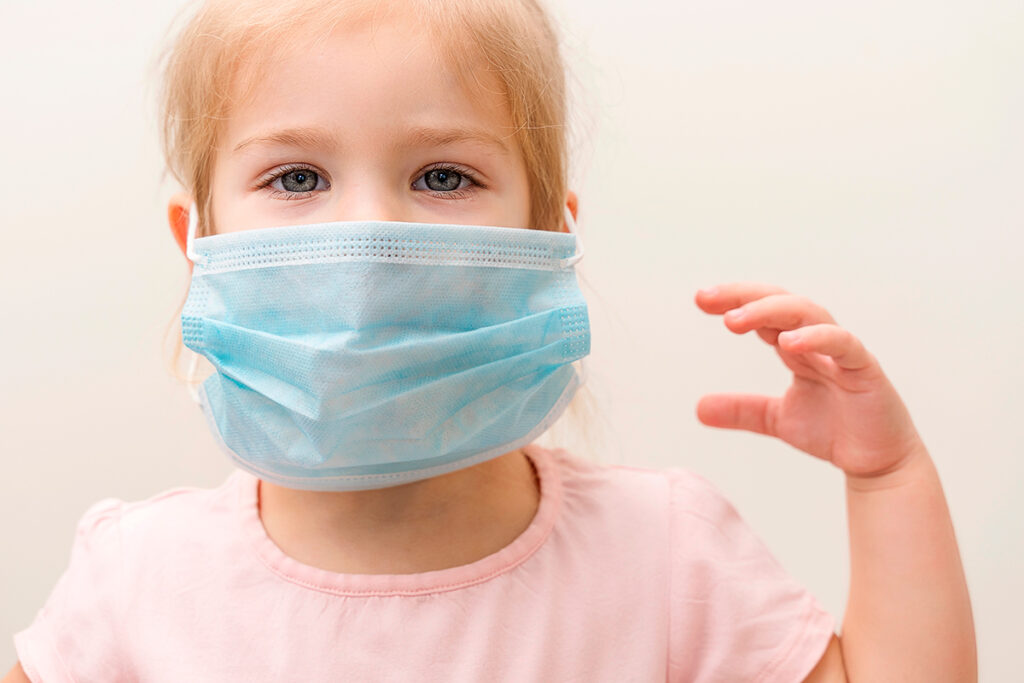Young people are less likely to contract COVID-19, which is reflected in statistics: with age, mortality from coronavirus increases sharply. Scientists have suggested that the child’s body may be better at suppressing SARS-CoV-2 infection.
The Body Triggers An Interferon Response To Suppress SARS-Cov-2 Infection
Innate immune cells recognize pathogens and tissue damage using pattern recognition receptors (PRR) on their surface. When SARS-CoV-2 PRR enters the body, they activate the type I and III interferon system (IFN).
Scientists recently compared impaired IFN response in children and adults with severe COVID-19. Studies have shown that the early mucosal immune response to SARS-CoV-2 is more potent in children than adults. However, the molecular defense mechanisms against COVID-19 in children, especially those without or with only mild/moderate symptoms, are still unknown.
Study: Why Children Are Less Susceptible To Severe COVID-19
German scientists have investigated what mechanisms children are better at suppressing SARS-CoV-2 at an early stage of infection. The study involved children and adults with asymptomatic, mild to moderate COVID-19.
Scientists analyzed 45 nasal swabs:
- 24 children aged 4 weeks to 17 years;
- 21 adults between the ages of 21 and 76.
Control group – 42 healthy people without a history of COVID-19:
- 18 children aged 4 to 16;
- 23 adults between the ages of 24 and 77.
Variable Cellular Compositions in The Upper Respiratory Tract in Children and Adults
Scientists have found 33 different types of cells in the upper respiratory tract of children and adults: 21 subtypes of immune cells and 12 subtypes of epithelial cells.
The composition of immune and epithelial cells of the nasal mucosa in children and adults differed significantly:
- Nasal swabs from healthy adults rarely showed immune cells, but swabs from healthy children contained large numbers of almost every subpopulation of immune cells, with a general predominance of neutrophils.
- During infection with SARS-CoV-2, the number of immune cells in adults increased, but the ratio of immune cells to epithelial cells remained almost stable in children.
- SARS-CoV-2 caused increased activation of childhood neutrophils. In adults, activation was less pronounced.
Interestingly, the composition of epithelial cells depends on age. For example, the number of goblet cells decreases with age, while the number of ciliated cells increases. Scientists at Northwestern University in the United States recently examined the cellular composition of the nasal mucosa in healthy and SARS-CoV-2 infected children and adults. Scientists were unable to identify the goblet cells specific to children but found that ciliated cells predominate in the mucous membrane of healthy children.
Expression of SARS-Cov-2 Entry Receptors Does Not Differ in Children and Adults
ACE2 is a cellular receptor that the SARS-CoV-2 viral particle uses to attach itself to a cell.
TMPRSS2 is a cell membrane protein that the SARS-CoV-2 viral particle uses to enter the cell.
Expression levels of ACE2 and TMPRSS2 did not differ in children and adults and did not increase in patients with mild to moderate COVID-19 compared with healthy people. Conclusion: the different courses of COVID-19 in children and adults cannot be explained by the different levels of ACE2 and TMPRSS2.
Children’s Epithelial Cells of The Respiratory Tract Have Increased Sensitivity to Viruses
SARS-CoV-2 multiplies very quickly. To suppress the infection, an early response of the innate immune system must be triggered in the body. This response is activated by various pattern recognition receptors (PRR). The main PRR for SARS-CoV-2 in epithelial cells is MDA5. RIG-I plays an additional but secondary role. An essential enhancer of MDA5 sensitivity is the LGP2 pattern recognition receptor.
PRRs are poorly expressed in epithelial cells. However, type I and III interferon enhances PRR expression. That plays a critical role in suppressing viral infection. Recently, clinical studies have confirmed that innate immunity errors in the PRR/IFN system increase the risk of severe COVID-19. Another study found that autoantibodies that neutralize type I interferons are present in 4% of uninfected people over the age of 70 and are responsible for 20% of deaths from COVID-19. More about this – in the review “Autoantibodies to interferon increase the risk of critical COVID-19 in the elderly.”
German scientists have found that genes encoding pattern recognition receptors RIG-I, MDA5, and LGP2 are expressed in epithelial cells of the upper respiratory tract much more strongly in healthy children than in adults. Conclusion: the children’s mucous membrane of the upper respiratory tract reacts more strongly to viral infections. That is confirmed by the increased number of innate immune cells in the children’s upper respiratory tract.
In the epithelial cells of children and adults infected with SARS-CoV-2, scientists also observed a high expression level of genes encoding PRR RIG-I, MDA5, and LGP2. Expression levels increased with the onset of COVID-19 symptoms, decreased by day 4 of illness, and remained at lower levels in the later phase of the disease (5-12 days after symptom onset). Scientists speculate that SARS-CoV-2 infection can be immediately identified by increased MDA5/LGP2 expression levels in epithelial cells.
Compared to adults with SARS-CoV-2, increased expression of MDA5 and LGP2 is observed in the epithelial cells of the respiratory tract in children. The differences are most outstanding in the early stages after the onset of symptoms (days 0-4). From the 5th day onwards, the differences are smoothed out.
When SARS-CoV-2 enters the body, pattern recognition receptors activate the IFN I and III system. Interferons induce an antiviral state in epithelial cells by increasing the number of MDA5 / LGP2 receptors and triggering the expression of interferon-stimulated genes (ISG).
Scientists have found strong ISG activation in the epithelial cells of children infected with SARS-CoV-2. These ISGs had potent antiviral effects. In all epithelial cells of children, particularly in ciliates, the level of ISG expression was significantly higher than in infected adults, both at the early and at the late stages of infection. Expression decreased in the later stages.
In the laboratory, scientists have demonstrated that with shallow levels of MDA5 expression in epithelial cells – such levels are observed in healthy adults – SARS-CoV-2 multiplies rapidly, and ISGs are expressed only slightly. However, in cells with moderately increased MDA5 expression, scientists observed significant expression of antiviral ISGs. Conclusion: MDA5 expression plays a central role in recognizing SARS-CoV-2 and initiating a rapid antiviral ISG response.
Innate Immunity Cells Activation is Increased in Children
Immune and epithelial cells interact more strongly in children than in adults, especially before infection. The most activated immune cells in children are:
- non-resident macrophages;
- macrophages derived from monocytes;
- dendritic cells.
These cells may play an additional role in virus detection and IFN production.
Specific Subpopulations of Immune Cells Found in Children
In addition to the increased antiviral state of the epithelial and immune cells of the respiratory tract, scientists have found particular subpopulations of immune cells in children. Among them is a subpopulation of cytotoxic T cells, which intensively produce toxins that destroy infected cells.
In addition, a unique population of cytotoxic T cells with memory was observed in children infected with SARS-CoV-2. This cell type was almost absent in adults. Whether these cells help protect children from future re-infection is not yet known.
Conclusions
Children suppress SARS-CoV-2 much faster and are less susceptible to severe COVID-19 than adults. Epithelial and immune cells of the upper respiratory tract in children are pre-activated and prepared to recognize viruses. When infected with SARS-CoV-2, pre-activated innate immunity in children leads to effective early interferon production in the respiratory tract, which causes antiviral effects. That reduces viral replication and promotes faster recovery in children.
Useful article, necessary information? Share it!
Someone will also find it useful and necessary:



